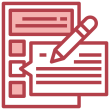WHY CHOOSE OUR NURSING WRITING SERVICES?
Are you in a situation where you are too busy and end up googling for “get nursing paper help online” or “do my nursing homework”? Nursing paper help provides nursing students with the assistance they need to complete their papers and projects on time. Our writers have expertise in a wide range of nursing subjects, such as nursing theory, nursing practice, nursing assessment, nursing research methods and more. Nursingpaperhelp.com provide guidance throughout the entire writing process to ensure that your nursing paper meets all academic requirements. With nursing paper help, you can be sure that your nursing papers are accurate and up-to-date with the latest nursing guidelines and standards.
Nursing paper help provide nursing essay writing services to nursing students who need assistance in crafting their nursing essays. Our writers have expertise in a wide range of topics related to nursing such as nursing ethics, nursing communication, nursing leadership, nursing theory and more. They will help in organizing your thoughts and ideas so that you can produce an outstanding nursing essay.
Nursing paper help writing services also offer timely delivery of nursing papers which is essential in ensuring the student submit the assignments on time. Furthermore, we provide revisions to ensure that the paper meets all requirements set by your professor. We guarantee 100% original nursing papers with zero-plagiarism to ensure your nursing paper is unique. With nursing paper help from our experienced writers, you can be sure of getting the grade you deserve.
All nursing essays are formatted according to the guidelines given by the instructor, ensuring that all instructions are met. Additonally, all the nursing papers are written to the highest academic writing standards, so you can be sure that your nursing paper will meet the professional standards required for a successful nursing career. Our nursing writers have years of experience in writing nursing essays and know exactly what is needed to get the best possible results.
Overall, our nursing services provide nursing students with quality papers that are tailored to their nursing field. With our nursing paper help, you can rest assured that the nursing essay you receive will be of the highest quality and completely original. We also offer plagiarism-free guarantee on all nursing papers so you won’t have to worry about any issues with your essay.
Time-saving
Nursing paper help can save time for nursing students by providing quality nursing papers with minimal effort required. Our nursing professionals can write all types of nursing assignments, from nursing essays to research papers and dissertations, all in record time so nursing students can focus on their studies.
Expertise
As a nursing student, you want a nursing paper help service that provides the best in tems of quality and expertise. At nursing paper help, we only employ nursing professionals who have years of experience in the nursing field. Our nursing experts are well-versed in nursing topics, from research methods to clinical nursing practices, so you can be sure that your nursing assignment will be written with atmost accuracy and precision.
Quality
When it comes to nursing assignments, quality is key. We guarantee that our nursing paper help service provides assignments that meet the highest standards in nursing writing. Our nursing professionals take great care to produce nursing papers that are well-resourced, accurate, and clear. The nursing writers use scholarly sources for research so that the nursing assignment are backed by established research.
Flexibility and customization
At NursingPaperHelp understand that nursing assignments aren’t one-size-fits all. That’s why we offer nursing paper help tailored to your individual nursing assignment needs. From choosing the level of writing service you need, to adding extra research materials, our nursing paper help will be designed for your specific nursing assignment.
On-time delivery
We know that nursing assignments can be challenging and we want to ensure you receive your nursing paper help at the time you need it. That’s why all nursing papers are delivered on or before schedule, so that you can submit them before the due date.
Highly qualified nursing writers
Our nursing paper help writers are nursing professionals with a high level of expertise. We guarantee that your nursing paper help will be written and edited by nursing specialists who understand the theories, concepts, and skills required for successful nursing assignments.
Complete customer satisfaction
We want you to feel confident and satisfied when ordering nursing paper help from us. That’s why our nursing paper help is personalized to meet your specific needs. We are committed to exceeding your expectations and making sure you get exactly what you need for the best results.
Free revisions
If, in any event, you are not satisfied with our nursing paper help, we will be happy to provide free revisions until all of your requirements have been met. All the revisions are free of charge and we won’t tire to do the revisions to your satisfaction.
Affordable nursing paper help
We understand the need to provide nursing paper help that is both efficient and cost-effective, which is why our nursing paper help is available at reasonable prices. We are committed to providing a quality service without breaking your bank. Nursing writing services from nursing paper help are very affordable. We understand that nursing students may be on a tight budget, and our prices reflect this. We offer competitive rates so you can get the nursing paper help you need without breaking the bank.














